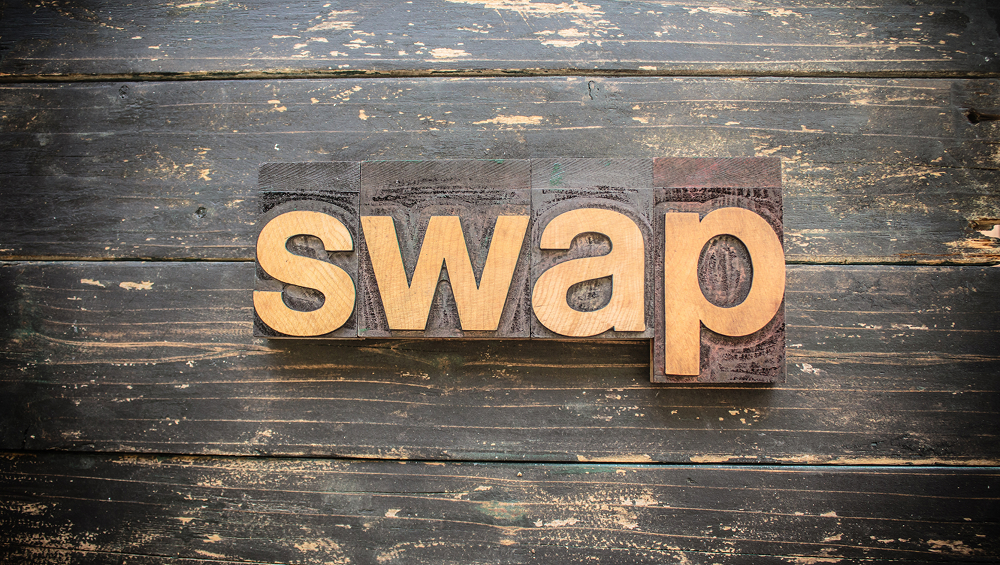Futures, forwards, swaps and options are considered the most basic or “plain vanilla” derivatives. Complex or “exotic” derivatives are created by combining different types of derivatives or by adding features to a traditional derivatives product.
Among these choices of trade, swap trading refers to a contract where two parties agree to exchange a pre-agreed cash flow or liability for a set period.
Swap trading is a feasible method of trade due to uncertain variables such as commodity price, equity price, interest rates, or foreign exchange rates. Based on these factors, traders can speculate on the spot and actual price, thereby securing profits.
How does Swap Trading Work?
Swap trading is over-the-counter (OTC) and it can happen with almost anything as long as it is a financial instrument.
The most common kind of swap is a currency rate swap.
A currency swap involves the exchange of an interest in one currency for the same in another currency. The parties agree in advance whether they will exchange the principal amounts of the two currencies and how much should be exchanged. With both values fixed, the implied exchange rate will stay until maturity.
Currency rate swaps are considered as an interest swap. This form of swap trading is often applied by nations with weak or developing economies to limit speculations against their currencies.
An example would be the Argentina and China currency swap. The swap was an attempt for China to stabilize its foreign reserves while Argentina could rebuild its reserves to cover trade costs and future debt repayments. Regarding the swap, on Nov 15, Reuters also reported that Argentina has agreed to expand its currency swap deal by $5 billion… a move that would give it more firepower to defend the embattled local peso.
Interest-Rate Swap
Interest Rate Swaps (IRS) An IRS is a transaction in which two parties agree to make periodic payments to each other, calculated on the basis of specified interest rates and a hypothetical (or notional) principal amount. Typically, the payment made by one party is calculated using a floating rate of interest (such as LIBOR), while the payment made by the other party is determined based on a fixed interest rate or a different floating rate.
In general, for interest-rate swaps, each cash flow comprises one leg of the swap. One cash flow is generally fixed, while the other is variable and based on a benchmark interest rate, floating currency exchange rate, or index price. This is also called a fixed-to-floating swap.
In this interest rate swap, two counterparties specify an exchange of payments benchmarked against an interest rate index. The most common IRS is a fixed for floating swap whereby one party will make payments to the other based on an initially agreed fixed rate of interest, and to receive back payments based on a floating interest rate index.
Interest rate swaps can be calculated quarterly and exchanged semi-annually, although this can change depending on the agreements between parties.
An example of a fixed-to-floating swap would be a commodity swap, in which the exchange floating commodity price of a product such as rubber or Brent crude Oil is agreed upon for a set price during a given period.
Alternatively, interest-rate swaps can also occur from a certain floating index to another. This is also called a float-to-float swap or a basis swap. For example, a company may swap a three-month to a six-month index because they speculate that interest rates rise, rates will be higher or if it matches the other strategies and cash flow.
Other Forms of Swaps
Other forms of swaps include debt-equity swaps, credit default swaps (CDS), and total returns swaps.
Debt-equity swaps involve the swapping of equity for debt and vice versa. It is a financial restructuring process where one party exchanges/ cancels another party’s debt in exchange for an equity position.
Credit default swaps are agreements by a party that offers insurance to the second party if a third-party default on a loan offered by the second party. In this circumstance, the first party offers to pay the principal amount that is lost as well as the interest on the loan.
A total return swap is a swap agreement in which one party makes payments based on a set rate, either fixed or variable, while the other party makes payments based on the return of an underlying asset, which includes both the income it generates and any capital gains. The swap is an example of a fund made up entirely of derivatives instruments.
Start Trading With Orient Futures Singapore
Being an Overseas Intermediary of Shanghai International Energy Exchange (INE), Dalian Commodity Exchange (DCE), and Zhengzhou Commodity Exchange (ZCE), when foreign clients participate in internationalised futures contracts in these Chinese markets with us, they have direct access to trading, clearing, and settlement. Our parent company, Shanghai Orient Futures, is the largest broker in terms of aggregated volume across the five regulated exchanges in China.
Orient Futures Singapore also currently holds memberships at the Singapore Exchange (SGX), Asia Pacific Exchange (APEX), and ICE Futures Singapore (ICE SG).
We provide premium customer service at an affordable cost to all our clients. Our team will be there for you 24 hours on trading days to provide a one-stop portal for all your trades, with simple processes and an intuitive user interface that has low or near-to-zero latency.




